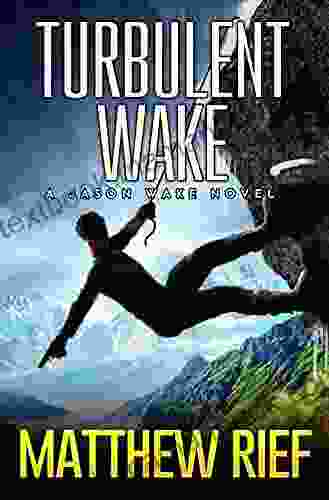Unveiling the Intricacies of Turbulent Wake Jason Wake: A Comprehensive Exploration

In the realm of fluid dynamics and aerospace engineering, the turbulent wake formed behind a moving object, often referred to as the Jason wake, presents a captivating area of study. This complex phenomenon is characterized by unsteady, chaotic flow patterns, offering valuable insights into the behavior of fluids and the intricate forces acting upon them.
4.5 out of 5
| Language | : | English |
| File size | : | 2665 KB |
| Text-to-Speech | : | Enabled |
| Screen Reader | : | Supported |
| Enhanced typesetting | : | Enabled |
| Word Wise | : | Enabled |
| Print length | : | 240 pages |
| Lending | : | Enabled |
Formation of Turbulent Wake
When an object moves through a fluid, such as air or water, it creates a disturbance in the surrounding fluid. This disturbance manifests as a region of low pressure behind the object, which draws fluid from the sides to fill the void. As the fluid flows around the object, it experiences a change in velocity and direction, leading to the formation of a boundary layer.
At low speeds, the boundary layer remains attached to the object's surface. However, as the speed increases, the boundary layer becomes unstable and separates from the surface, forming a shear layer. This shear layer is characterized by a velocity gradient, where the fluid velocity changes rapidly over a short distance. The instability within the shear layer leads to the formation of vortices, which are rotating fluid elements.
These vortices shed from the trailing edge of the object, creating a turbulent wake. The wake is characterized by highly unsteady and chaotic flow patterns, with eddies and vortices of varying sizes and strengths. The size and intensity of the wake depend on factors such as the object's shape, velocity, and the properties of the fluid.
Characteristics of Turbulent Wake
Turbulent wakes exhibit unique characteristics that distinguish them from laminar wakes. Key features of turbulent wakes include:
- Unsteady and Chaotic Flow: Turbulent wakes are characterized by highly irregular and unpredictable flow patterns. The velocity and pressure fluctuate rapidly, creating a chaotic environment.
- Vortex Shedding: As the fluid flows past the object, vortices are shed from the trailing edge. These vortices are responsible for the unsteady and chaotic nature of the wake.
- Broad Spectrum of Scales: Turbulent wakes contain a wide range of eddy sizes, from small-scale eddies near the object's surface to large-scale eddies in the far wake.
- High Mixing: The chaotic flow patterns within turbulent wakes promote mixing between the fluid layers. This mixing enhances heat and mass transfer, making turbulent wakes important in various industrial applications.
Significance of Turbulent Wake
Turbulent wake plays a crucial role in fluid dynamics and aerospace engineering. Understanding its behavior is essential for analyzing and designing various systems that involve fluid flow.
In aerospace engineering, the turbulent wake behind aircraft and rockets is of particular interest. The wake can affect the stability and performance of the vehicle, impacting drag, lift, and controllability. Engineers use computational fluid dynamics (CFD) simulations and wind tunnel experiments to study the wake and optimize vehicle designs.
In fluid dynamics, turbulent wakes are studied to understand the mechanisms of turbulence. Researchers use experimental techniques, such as particle image velocimetry (PIV) and laser Doppler velocimetry (LDV),to measure the flow patterns and characterize the statistical properties of the wake.
Turbulence Modeling
Predicting the behavior of turbulent wakes is a challenging task due to their complex and chaotic nature. Turbulence modeling techniques are employed to approximate the turbulent flow and estimate key parameters, such as velocity, pressure, and Reynolds stresses.
Various turbulence models are available, ranging from simple algebraic models to more sophisticated Reynolds-averaged Navier-Stokes (RANS) models and large eddy simulations (LES). The choice of turbulence model depends on factors such as the accuracy required, computational resources, and the specific application.
The turbulent wake Jason wake is a fascinating phenomenon in fluid dynamics and aerospace engineering. Its formation, characteristics, and significance provide valuable insights into the behavior of fluids and the intricate forces acting upon them. Understanding turbulent wakes is crucial for analyzing and designing various systems that involve fluid flow, including aircraft, rockets, and industrial processes.
Ongoing research in turbulence modeling aims to improve the accuracy and efficiency of predicting turbulent flows. Advancements in computational power and experimental techniques continue to enhance our understanding of turbulent wakes and their implications in fluid dynamics and aerospace engineering.
4.5 out of 5
| Language | : | English |
| File size | : | 2665 KB |
| Text-to-Speech | : | Enabled |
| Screen Reader | : | Supported |
| Enhanced typesetting | : | Enabled |
| Word Wise | : | Enabled |
| Print length | : | 240 pages |
| Lending | : | Enabled |
Do you want to contribute by writing guest posts on this blog?
Please contact us and send us a resume of previous articles that you have written.
 Top Book
Top Book Novel
Novel Fiction
Fiction Nonfiction
Nonfiction Literature
Literature Paperback
Paperback Hardcover
Hardcover E-book
E-book Audiobook
Audiobook Bestseller
Bestseller Classic
Classic Mystery
Mystery Thriller
Thriller Romance
Romance Fantasy
Fantasy Science Fiction
Science Fiction Biography
Biography Memoir
Memoir Autobiography
Autobiography Poetry
Poetry Drama
Drama Historical Fiction
Historical Fiction Self-help
Self-help Young Adult
Young Adult Childrens Books
Childrens Books Graphic Novel
Graphic Novel Anthology
Anthology Series
Series Encyclopedia
Encyclopedia Reference
Reference Guidebook
Guidebook Textbook
Textbook Workbook
Workbook Journal
Journal Diary
Diary Manuscript
Manuscript Folio
Folio Pulp Fiction
Pulp Fiction Short Stories
Short Stories Fairy Tales
Fairy Tales Fables
Fables Mythology
Mythology Philosophy
Philosophy Religion
Religion Spirituality
Spirituality Essays
Essays Critique
Critique Commentary
Commentary Glossary
Glossary Bibliography
Bibliography Index
Index Table of Contents
Table of Contents Preface
Preface Introduction
Introduction Foreword
Foreword Afterword
Afterword Appendices
Appendices Annotations
Annotations Footnotes
Footnotes Epilogue
Epilogue Prologue
Prologue Elias Aldada
Elias Aldada Richard Henry
Richard Henry Alex Ross
Alex Ross Jonathan Martin
Jonathan Martin Rajiv L B Roy
Rajiv L B Roy L T Vargus
L T Vargus David Conway
David Conway Louis L Amour
Louis L Amour Douglas Deur
Douglas Deur Lh Nicole
Lh Nicole Claudio Valerio Gaetani
Claudio Valerio Gaetani Telannia Norfar
Telannia Norfar Jennifer Paganelli
Jennifer Paganelli Guy Haley
Guy Haley Andrew Sean Greer
Andrew Sean Greer Melissa M Martin
Melissa M Martin Anthony Haight
Anthony Haight Elliot W Eisner
Elliot W Eisner Alex Xu
Alex Xu Luciano Simonelli
Luciano Simonelli
Light bulbAdvertise smarter! Our strategic ad space ensures maximum exposure. Reserve your spot today!

 Darius CoxUnlock the Gateway to Boundless Wisdom: Infinite Wisdom Volume Two by La Sha...
Darius CoxUnlock the Gateway to Boundless Wisdom: Infinite Wisdom Volume Two by La Sha... Lawrence BellFollow ·2.2k
Lawrence BellFollow ·2.2k Mario BenedettiFollow ·2.4k
Mario BenedettiFollow ·2.4k Shaun NelsonFollow ·5.6k
Shaun NelsonFollow ·5.6k Cooper BellFollow ·16.7k
Cooper BellFollow ·16.7k Kelly BlairFollow ·13.5k
Kelly BlairFollow ·13.5k Colin RichardsonFollow ·9.3k
Colin RichardsonFollow ·9.3k Denzel HayesFollow ·18.6k
Denzel HayesFollow ·18.6k Levi PowellFollow ·13.1k
Levi PowellFollow ·13.1k

 Forrest Reed
Forrest ReedHulusi Darende's Poems: Unraveling the Lyrical Tapestry...
: A Journey into the Heart of Sufi...

 Gabriel Blair
Gabriel BlairAct of Terror: A Jericho Quinn Thriller
In the heart-pounding...

 Zadie Smith
Zadie SmithScales for Strings Teacher Manual: A Comprehensive Guide...
Scales are fundamental building blocks of...

 Hugo Cox
Hugo CoxMermaid (NHB Modern Plays) Polly Teale
The Mermaid NHB Modern Plays series, a...
4.5 out of 5
| Language | : | English |
| File size | : | 2665 KB |
| Text-to-Speech | : | Enabled |
| Screen Reader | : | Supported |
| Enhanced typesetting | : | Enabled |
| Word Wise | : | Enabled |
| Print length | : | 240 pages |
| Lending | : | Enabled |












